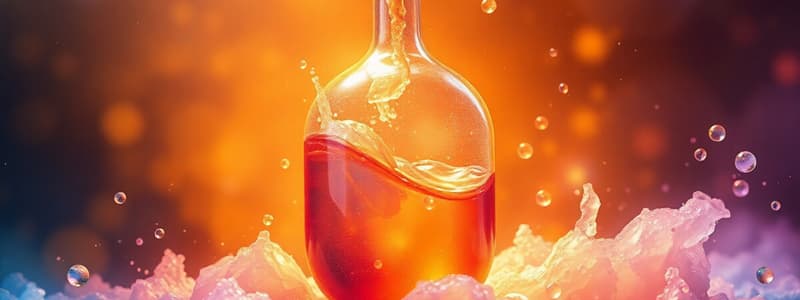Podcast
Questions and Answers
Which of the following statements is true regarding pure substances?
Which of the following statements is true regarding pure substances?
- A pure substance is always a single atom.
- Pure substances can be either elements or compounds. (correct)
- Mixtures of pure substances are chemically bonded.
- Pure substances can only be mixtures.
What method can be used to separate a mixture based on differing boiling points?
What method can be used to separate a mixture based on differing boiling points?
- Filtration
- Distillation (correct)
- Magnetism
- Chromatography
Which of the following best describes a homogeneous mixture?
Which of the following best describes a homogeneous mixture?
- Contains visibly different substances.
- Is uniform throughout. (correct)
- Is separable by filtration.
- Includes only pure elements.
According to the Law of Constant Composition, what remains constant in a compound?
According to the Law of Constant Composition, what remains constant in a compound?
Which of the following represents the relative charge and mass of a proton?
Which of the following represents the relative charge and mass of a proton?
What is the correct expression for calculating the heat of reaction (∆Hrxn)?
What is the correct expression for calculating the heat of reaction (∆Hrxn)?
Which of the following statements about spontaneous processes is true?
Which of the following statements about spontaneous processes is true?
Under what conditions do real gases behave most like ideal gases?
Under what conditions do real gases behave most like ideal gases?
What is the value of entropy at absolute zero for a perfectly ordered crystal?
What is the value of entropy at absolute zero for a perfectly ordered crystal?
What defines the term 'enthalpy change at standard state'?
What defines the term 'enthalpy change at standard state'?
What is the combined gas law equation?
What is the combined gas law equation?
According to Graham's Law, how is the ratio of velocities of two gases related?
According to Graham's Law, how is the ratio of velocities of two gases related?
How is the total pressure of a gas mixture defined according to Dalton’s law?
How is the total pressure of a gas mixture defined according to Dalton’s law?
What is the primary difference between molecular and ionic compounds?
What is the primary difference between molecular and ionic compounds?
Which prefix is used to denote three carbon atoms in organic compounds?
Which prefix is used to denote three carbon atoms in organic compounds?
Which of the following is the correct nomenclature for a binary acid with no oxygen?
Which of the following is the correct nomenclature for a binary acid with no oxygen?
How do you determine the limiting reactant in a chemical reaction?
How do you determine the limiting reactant in a chemical reaction?
What defines a strong electrolyte?
What defines a strong electrolyte?
In an exothermic reaction, which of the following occurs?
In an exothermic reaction, which of the following occurs?
What is the purpose of using Roman numerals in ionic compound nomenclature?
What is the purpose of using Roman numerals in ionic compound nomenclature?
Which statement is true according to the law of conservation of mass?
Which statement is true according to the law of conservation of mass?
What is the general form of a combustion reaction?
What is the general form of a combustion reaction?
What represents the percent yield in a chemical reaction?
What represents the percent yield in a chemical reaction?
How is the heat capacity of a substance defined?
How is the heat capacity of a substance defined?
When calculating the enthalpy change for a reaction, what is considered the 'reverse reaction'?
When calculating the enthalpy change for a reaction, what is considered the 'reverse reaction'?
How does one find the empirical formula multiplier?
How does one find the empirical formula multiplier?
In terms of oxidation numbers, what is the oxidation state of oxygen in peroxides?
In terms of oxidation numbers, what is the oxidation state of oxygen in peroxides?
Flashcards
Compound
Compound
A pure substance composed of two or more different elements chemically bonded together in a fixed ratio.
Distillation
Distillation
The process of separating a mixture by exploiting differences in boiling points. The substance with the lower boiling point vaporizes first, then condenses and is collected separately.
Physical Property
Physical Property
A specific characteristic of a substance that can be observed or measured without changing the substance's identity.
Chemical Property
Chemical Property
Signup and view all the flashcards
Homogeneous Mixture
Homogeneous Mixture
Signup and view all the flashcards
Enthalpy Change (∆H)
Enthalpy Change (∆H)
Signup and view all the flashcards
Heat of Formation (∆Hf)
Heat of Formation (∆Hf)
Signup and view all the flashcards
Thermodynamically Feasible
Thermodynamically Feasible
Signup and view all the flashcards
Entropy (∆S)
Entropy (∆S)
Signup and view all the flashcards
Gibbs Free Energy (∆G)
Gibbs Free Energy (∆G)
Signup and view all the flashcards
Kinetic Energy of Gases
Kinetic Energy of Gases
Signup and view all the flashcards
Dalton's Law of Partial Pressures
Dalton's Law of Partial Pressures
Signup and view all the flashcards
Graham's Law of Effusion
Graham's Law of Effusion
Signup and view all the flashcards
Molecular Compound
Molecular Compound
Signup and view all the flashcards
Ionic Compound
Ionic Compound
Signup and view all the flashcards
Acid
Acid
Signup and view all the flashcards
Organic Compound
Organic Compound
Signup and view all the flashcards
Law of Conservation of Mass
Law of Conservation of Mass
Signup and view all the flashcards
Synthesis Reaction
Synthesis Reaction
Signup and view all the flashcards
Decomposition Reaction
Decomposition Reaction
Signup and view all the flashcards
Single Replacement Reaction
Single Replacement Reaction
Signup and view all the flashcards
Double Displacement Reaction
Double Displacement Reaction
Signup and view all the flashcards
Combustion Reaction
Combustion Reaction
Signup and view all the flashcards
Empirical Formula Multiplier
Empirical Formula Multiplier
Signup and view all the flashcards
Percent Yield
Percent Yield
Signup and view all the flashcards
Limiting Reactant
Limiting Reactant
Signup and view all the flashcards
Strong Electrolyte
Strong Electrolyte
Signup and view all the flashcards
Study Notes
Unit 1: Matter and Mixtures
- Matter has mass and volume.
- Matter is categorized as either a pure substance or a mixture.
- Pure substances are further divided into elements and compounds.
- Mixtures are combinations of two or more pure substances not chemically bonded.
- Mixture separation methods include filtration (particle size), distillation (boiling point), centrifuging (density), magnetism (Fe, Co, Mn), and chromatography (polarity).
- Physical properties describe matter without changing its identity, such as taste, smell, molar mass, density, melting point, boiling point, and freezing point.
- Chemical properties describe how matter reacts with other substances, such as reactions with oxygen, acids, and bases, burning.
- Density (D) = mass (m) / volume (v).
- A compound is two or more different elements bonded chemically.
- The Law of Constant Composition states a compound always contains the same elements in the same proportion.
- Seven diatomic elements are Br, I, N, Cl, H, O, F.
- Heterogeneous mixtures are not uniform throughout.
- Homogeneous mixtures are uniform throughout.
- Prefixes: kilo (k) = 103, centi (c) = 10-2, milli (m) = 10-3.
- Significant figures: Addition/subtraction—least decimal places; Multiplication/division—least significant figures.
Unit 2: Atoms and Compounds
- Law of Constant Composition (Definite Proportions): Compounds have definite elemental ratios.
- Subatomic particles—electrons, protons, and neutrons—have specific charges, relative charges, masses, and locations within the atom.
- Atomic mass is a weighted average of isotopes.
- Compounds, combinations of elements, have unique chemical and physical properties.
- Types of compounds include molecular (nonmetals bonded) and ionic (metal and nonmetal bonded).
- Acids start with hydrogen, while organic compounds contain carbon and hydrogen.
- Molecular compound nomenclature: Name the more metallic element first, drop the ending of the second and add -ide, avoid mono- prefix if it's not needed and avoid reducing subscripts.
- Binary molecules use Greek prefixes (mono- one; di- two...deca- ten) for element quantities.
- Ions are charged atoms (cations positive, anions negative).
- In ionic compound nomenclature, write the metal first, use charges for ratios, and drop the ending (if binary) or add roman numerals for multiple charges.
- Acid nomenclature: "Hydro" + anion ending (-ic) or use polyatomic anion.
- Organic compound nomenclature: Prefixes indicate carbon quantity (meth- 1, eth-2...), and alkanes end in "-ane." Alcohols end in "-ol."
Unit 3: Chemical Reactions
- Law of Conservation of Mass: Mass is conserved in chemical reactions.
- Synthesis (A + B → AB), Decomposition (AB → A + B), Single Replacement (AB + C → AC + B), Double Displacement (AB + CD → AD + CB), Combustion (CxHy(Oz) + O2 → CO2 + H2O) are reaction types.
- Empirical formula multiplier = Molar mass / Empirical formula mass.
- Percent yield = (experimental mass / theoretical mass) x 100.
- Limiting reactant problems: Divide reactant moles by their coefficients, smallest is limiting.
- Solve for product/reactant masses using stoichiometry and limiting reactant.
Unit 4: Electrolytes and Reactions
- Strong electrolytes conduct electricity well and dissociate completely in water. This includes soluble ionic compounds, strong acids (HCl, HBr, HI, HNO3, H2SO4, HClO4, HClO3), and strong bases (LiOH, NaOH, KOH, Ca(OH)2, Sr(OH)2, Ba(OH)2).
- Weak electrolytes conduct electricity poorly and dissociate incompletely. Weak acids and weak bases belong to this category.
- Non-electrolytes do not conduct electricity and usually are covalent compounds, or insoluble ionic compounds.
- Metathesis reactions (double displacement) occur when a precipitate, water, or gas is formed.
- Acid-base reactions form a salt and water.
- Oxidation-reduction (redox) reactions involve electron transfer (LEO goes GER - Loss of Electrons is Oxidation, Gain of Electrons is Reduction).
- Oxidation states: Pure elements are zero; common ions have fixed states.
- Activity series lists metals in order of decreasing ease of oxidation; the less reactive element is reduced.
- Molarity (M) = moles of solute / liters of solution.
Unit 5: Thermodynamics and Calorimetry
- Temperature is the average kinetic energy, while heat is total energy.
- Endothermic reactions absorb energy, exothermic reactions release energy.
- Energy changes (∆H) in chemical reactions can be calculated graphically (∆H = Hproducts - Hreactants).
- Joule stoichiometry: Coefficients relate to moles. States matter.
- Calorimetry: Heat capacity (∆H = mc∆T) is the energy to raise 1 g of substance by 1˚C.
- Calculations for heat of solution/neutralization involve (m)(C)(∆T) calculations, water heat capacity is often 4.184J/g˚C
- Bomb calorimeter: ∆H = Cp(cal) ∆T (including the calorimeter's contribution).
- Hess's Law: Manipulate equations to find ∆H of an overall reaction.
- Heats of formation (∆Hf): Energy to make 1 mole of compound from elements at standard state (pure elements = 0 ∆Hf).
- Bond energies: Calculate ∆H by summing bond breaking and bond formation energies.
Unit 19: Thermodynamics and Spontaneity
- Thermodynamically feasible processes (spontaneous) have two driving forces: lower energy (exothermic, - ∆H), and increased disorder (higher entropy, +∆S).
- Entropy (S) is the measure of system disorder; it increases with higher number of atoms/molar mass, liquid/solid dissolution, gas volume, and temperature.
- Spontaneous processes: ∆G˚ = ∆H˚ - T∆S˚.
- ∆H˚, ∆S˚ positive and negative values determine how temperature affects whether a reaction is spontaneous.
Unit 10: Ideal Gas Laws
- Gases at the same temperature have the same kinetic energy.
- Dalton's Law: PTotal = Pgas A + Pgas B...
- Manometers measure gas pressure. Combined Gas Law (PV = nRT), Dalton's Law, and Raoult's Law are important concepts to remember for this unit.
- Graham's Law: The rate of gas effusion is inversely proportional to the square root of its molar mass.
- Real gases deviate from ideal behavior at high pressure and low temperature.
Studying That Suits You
Use AI to generate personalized quizzes and flashcards to suit your learning preferences.




